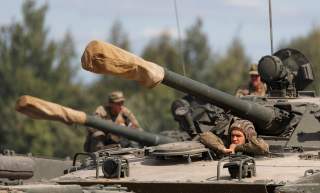Why 'Robot Wars' Might Not Be Our Future
Despite the popular consensus that robot war is inevitable, future conflicts might look more like those of the past than some care to let on.
In sum, despite the fact that robotics and AI have soaked up the most sunlight as of late, America’s competitors have not only maintained vast human armies, but are also expanding them or making significant improvements to their composition and strength.
Looking Ahead
As research and development in the field of militarized robotics pushes forward, it is important to remember that America’s future enemies will—as they have in the past—take the path of least resistance in war, expose weaknesses, and exploit them. If the United States becomes dependent upon AI and robots to fight its wars, it will create a new center-of-gravity and reveal its weakness: A ground war with high human casualties. In turn, the strategic objective of any opponent at war with the United States would be to draw it into precisely such a conflict by mitigating its technological advantages.
Pentagon official Jeff Becker noted recently in the National Interest that it is premature to dismiss the role of AI in future wars based merely on its potential shortfalls. Likewise, it is also premature to assume that robots will deliver as promised in future wars based merely on their potential capabilities. Similar to arguments in the Unrestricted Warfare thesis (China’s response to the projection of American military power during the First Gulf War), domination in these emerging areas is not a sure path to victory—in part because this would prompt adversaries to seek other means of leverage, and encourage the United States to allow its more seasoned domains of war to atrophy (air, land and sea).
That said, the policies of Secretary of Defense Jim Mattis and Secretary of the Army Mark Esper prove that they are acutely aware of challenges related to Joint Force lethality. Over the last eighteen months, both officials have taken swift action to underscore the importance of unit readiness, talent management, and leader development.
Does this mean the United States needs to pack up its future war programs and fix bayonets? Certainly not.
But it does mean that Western leaders should be wary of the temptation to acquire tunnel vision in their endeavor to remain militarily competitive. As Williamson Murray and Allan Millett surmised in their analysis of military innovation in the interwar period, having a vision of future war is important, but that view “must also be balanced and well connected to operational realities.”
One of those realities is the sheer vastness of human capital that America’s adversaries would likely be willing to expend in a war with the United States—especially if those opponents view troop strength and combined arms maneuver as their strongest hands against an enemy who has subordinated both to machines. Without a highly motivated, expertly trained, and masterfully-led Joint Force willing to contend with such a challenge, all the back-flipping robots in the world won’t bail the United States out of the next war.
Michael P. Ferguson, M.S., is an officer of the United States Army with experience throughout Europe and the Middle East. A former instructor at the U.S. Army Ranger School, he often writes on issues concerning strategic theory. The author’s views are his own, and do not reflect the official positions or policies of the U.S. Army, the Department of Defense, or the U.S. government.
Image: Reuters

